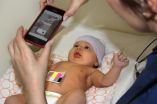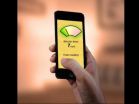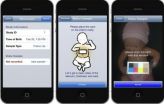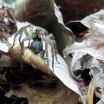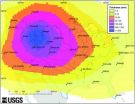(Press-News.org) Newborn jaundice: It's one of the last things a parent wants to deal with, but it's unfortunately a common condition in babies less than a week old.
Skin that turns yellow can be a sure sign that a newborn is jaundiced and isn't adequately eliminating the chemical bilirubin. But that discoloration is sometimes hard to see, and severe jaundice left untreated can harm a baby.
University of Washington engineers and physicians have developed a smartphone application that checks for jaundice in newborns and can deliver results to parents and pediatricians within minutes. It could serve as a screening tool to determine whether a baby needs a blood test – the gold standard for detecting high levels of bilirubin.
"Virtually every baby gets jaundiced, and we're sending them home from the hospital even before bilirubin levels reach their peak," said James Taylor, a UW professor of pediatrics and medical director of the newborn nursery at UW Medical Center. "This smartphone test is really for babies in the first few days after they go home. A parent or health care provider can get an accurate picture of bilirubin to bridge the gap after leaving the hospital."
The research team will present its results at the Association for Computing Machinery's International Joint Conference on Pervasive and Ubiquitous Computing in September in Seattle.
The app, called BiliCam, uses a smartphone's camera and flash and a color calibration card the size of a business card. A parent or health care professional would download the app, place the card on her baby's belly, then take a picture with the card in view. The card calibrates and accounts for different lighting conditions and skin tones. Data from the photo are sent to the cloud and are analyzed by machine-learning algorithms, and a report on the newborn's bilirubin levels is sent almost instantly to the parent's phone.
"This is a way to provide peace of mind for the parents of newborns," said Shwetak Patel, a UW associate professor of computer science and engineering and of electrical engineering. "The advantage of doing the analysis in the cloud is that our algorithms can be improved over time."
A noninvasive jaundice screening tool is available in some hospitals and clinics, but the instrument costs several thousand dollars and isn't feasible for home use. Currently, both doctors and parents assess jaundice by looking for the yellow color in a newborn's skin, but this visual assessment is only moderately accurate. The UW team developed BiliCam to be easy to use and affordable for both clinicians and parents, especially during the first several days after birth when it's crucial to check for jaundice.
Jaundice, or the yellowing of the skin, can happen when an excess amount of bilirubin collects in the blood. Bilirubin is a natural byproduct of the breakdown of red blood cells, which the liver usually metabolizes. But newborns often metabolize bilirubin slower because their livers aren't yet fully functioning. If left untreated, severe jaundice can cause brain damage and a potentially fatal condition called kernicterus.
The UW team ran a clinical study with 100 newborns and their families at UW Medical Center. They used a blood test, the current screening tool used in hospitals, and BiliCam to test the babies when they were between two and five days old. They found that BiliCam performed as well as or better than the current screening tool. Though it wouldn't replace a blood test, BiliCam could let parents know if they should take that next step.
"BiliCam would be a significantly cheaper and more accessible option than the existing reliable screening methods," said Lilian de Greef, lead author and a UW doctoral student in computer science and engineering. "Lowering the access barrier to medical applications can have profound effects on patients, their caregivers and their doctors, especially for something as prevalent as newborn jaundice."
The researchers plan to test BiliCam on up to 1,000 additional newborns, especially those with darker skin pigments. The algorithms will then be robust enough to account for all ethnicities and skin colors. This could make BiliCam a useful tool for parents and health care workers in developing countries where jaundice accounts for many newborn deaths.
"We're really excited about the potential of this in resource-poor areas, something that can make a difference in places where there aren't tools to measure bilirubin but there's good infrastructure for mobile phones," Taylor said.
Within a year, the researchers say BiliCam could be used by doctors as an alternative to the current screening procedures for bilirubin. They have filed patents on the technology, and within a couple of years hope to have Federal Drug Administration approval for the BiliCam app that parents can use at home on their smartphones.
INFORMATION:
Other members of the research team are Mayank Goel and Min Joon Seo, UW doctoral students in computer science and engineering; Eric Larson of Southern Methodist University; and James Stout of the UW pediatrics department.
This research is funded by the Coulter Foundation and a National Science Foundation Graduate Research Fellowship.
For more information, contact the research team at bilicam@cs.washington.edu. Members of the research team are available to demonstrate the technology.
BiliCam website: http://www.bilicam.com/
Related research paper: http://homes.cs.washington.edu/~mayank/BiliCam.pdf
New smartphone app can detect newborn jaundice in minutes
2014-08-27
ELSE PRESS RELEASES FROM THIS DATE:
Parents, listen next time your baby babbles
2014-08-27
Pay attention, mom and dad, especially when your infant looks at you and babbles.
Parents may not understand a baby's prattling, but by listening and responding, they let their infants know they can communicate which leads to children forming complex sounds and using language more quickly.
That's according to a new study by the University of Iowa and Indiana University that found how parents respond to their children's babbling can actually shape the way infants communicate and use vocalizations.
The findings challenge the belief that human communication is innate ...
Lifetime of fitness: A fountain of youth for bone and joint health?
2014-08-27
ROSEMONT, Ill.—Being physically active may significantly improve musculoskeletal and overall health, and minimize or delay the effects of aging, according to a review of the latest research on senior athletes (ages 65 and up) appearing in the September issue of the Journal of the American Academy of Orthopaedic Surgeons (JAAOS).
It long has been assumed that aging causes an inevitable deterioration of the body and its ability to function, as well as increased rates of related injuries such as sprains, strains and fractures; diseases, such as obesity and diabetes; and ...
Educated consumers more likely to use potentially unreliable online healthcare information
2014-08-27
The last time you experienced worrisome medical symptoms, did you look for advice online before consulting a health-care professional? If so, you're not alone. Consumers are increasingly turning to forums, video-sharing sites, and peer support groups to gather anecdotal information and advice, which may distract them from more reliable and trustworthy sources. New research to be presented at the HFES 2014 Annual Meeting in Chicago studies the characteristics of consumers who use the Internet to collect health-care information.
"Age, educational levels, and health status ...
Southwest may face 'megadrought' this century
2014-08-27
Due to global warming, scientists say, the chances of the southwestern United States experiencing a decade long drought is at least 50 percent, and the chances of a "megadrought" – one that lasts over 30 years – ranges from 20 to 50 percent over the next century.
The study by Cornell University, University of Arizona and U.S. Geological Survey researchers will be published in a forthcoming issue of the American Meteorological Society's Journal of Climate.
"For the southwestern U.S., I'm not optimistic about avoiding real megadroughts," said Toby Ault, Cornell assistant ...
Scientist uncovers red planet's climate history in unique meteorite
2014-08-27
TALLAHASSEE, Fla. — Was Mars — now a cold, dry place — once a warm, wet planet that sustained life? And if so, how long has it been cold and dry?
Research underway at the National High Magnetic Field Laboratory may one day answer those questions — and perhaps even help pave the way for future colonization of the Red Planet. By analyzing the chemical clues locked inside an ancient Martian meteorite known as Black Beauty, Florida State University Professor Munir Humayun and an international research team are revealing the story of Mars' ancient, and sometimes startling, ...
MU researchers develop more accurate Twitter analysis tools
2014-08-27
COLUMBIA, Mo. – "Trending" topics on the social media platform Twitter show the quantity of tweets associated with a specific event. However, trends only show the highest volume keywords and hashtags, and may not give qualitative information about the tweets themselves. Now, using data associated with the Super Bowl and World Series, researchers at the University of Missouri have developed and validated a software program that analyzes event-based tweets and measures the context of tweets rather than just the quantity. The program will help Twitter analysts gain better ...
Marijuana compound may offer treatment for Alzheimer's disease
2014-08-27
Tampa, FL (Aug. 26, 2014) -- Extremely low levels of the compound in marijuana known as delta-9-tetrahydrocannabinol, or THC, may slow or halt the progression of Alzheimer's disease, a recent study from neuroscientists at the University of South Florida shows.
Findings from the experiments, using a cellular model of Alzheimer's disease, were reported online in the Journal of Alzheimer's Disease.
Researchers from the USF Health Byrd Alzheimer's Institute showed that extremely low doses of THC reduce the production of amyloid beta, found in a soluble form in most aging ...
More wolf spiders feasting on American toads due to invasive grass, UGA study shows
2014-08-27
Athens, Ga. – An invasive grass species frequently found in forests has created a thriving habitat for wolf spiders, who then feed on American toads, a new University of Georgia study has found.
Japanese stiltgrass, which was accidentally introduced to the U.S. in the early 1900s, is one of the most pervasive invasive species and has spread to more than a dozen states in the past century, particularly in the Southeast. Typically found along roads and in forests, it can survive in widely diverse ecosystems and has been found to impact native plant species, invertebrate ...
Orion rocks! Pebble-size particles may jump-start planet formation
2014-08-27
Rocky planets like Earth start out as microscopic bits of dust tinier than a grain of sand, or so theories predict.
Astronomers using the National Science Foundation's (NSF) Green Bank Telescope (GBT) have discovered that filaments of star-forming gas near the Orion Nebula may be brimming with pebble-size particles -- planetary building blocks 100 to 1,000 times larger than the dust grains typically found around protostars. If confirmed, these dense ribbons of rocky material may well represent a new, mid-size class of interstellar particles that could help jump-start ...
AGU: Yellowstone supereruption would send ash across North America
2014-08-27
WASHINGTON, D.C. – In the unlikely event of a volcanic supereruption at Yellowstone National Park, the northern Rocky Mountains would be blanketed in meters of ash, and millimeters would be deposited as far away as New York City, Los Angeles and Miami, according to a new study.
An improved computer model developed by the study's authors finds that the hypothetical, large eruption would create a distinctive kind of ash cloud known as an umbrella, which expands evenly in all directions, sending ash across North America.
A supereruption is the largest class of volcanic ...
